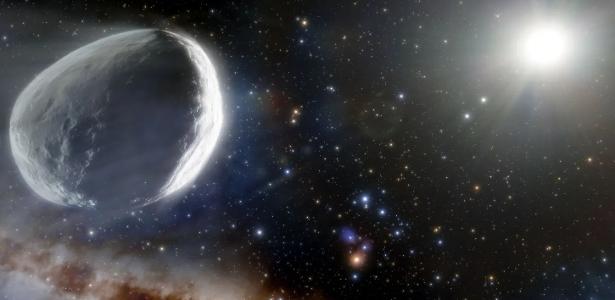
New images from the Hubble Space Telescope confirm: Megacomet C/2014 UN271 is the largest ever detected. Its frozen core is about 140 km wide and has a mass of about 500 trillion tonnes.
According to NASA, this is a . is about 50 times larger than “Ordinary” Comet, and is moving towards the Sun, approaching the Earth. For comparison purposes, the neowise, which recently met us, is 5 km wide. Hale-Bopp, which is considered large, is 50 km long; and the famous heli 15 km.
The comet is also called Bernardinelli-Bernstein because of one of its discoverers. Brazilian astronomer Pedro Bernardinelli, He and American colleague Gary Bernstein, both from the University of Pennsylvania, identified C/2014 UN271 while digging through the image archive of the Dark Energy Survey, a survey of the expansion of the universe.
“We always suspected that this comet must be large, because it is so bright at such a great distance. Now, we have confirmed that it is,” said David Zwitt, professor of planetary science and astronomy at the University of California. in Los Angeles (UCLA) and co-author of a new study that confirms the shape of a space object.
“This comet is literally the tip of thousands more icebergs that are too faint to be seen in the most distant parts of the Solar System.” The previous record was held in 2002 by C/2002 VQ94, which had an estimated core of 96km in diameter.
Bernardinelli-Bernstein began its journey toward the Sun a million years ago, probably from the hypothetical Oort Cloud, the farthest region in the Solar System where billions of comets would be concentrated. Now, it is far away from Earth, running at 35,405 km/h.
But there is nothing to panic: according to NASA, it will be closest to our planet in 2031 at a distance of 1.6 billion kilometers. It will cross the solar system between the orbits of Saturn and Uranus, without any risk of impact.
How did you calculate your size?
The first recorded location of the mysterious object was by Bardinadelli and Bernstein from the Cerro Tololo Inter-American Observatory in Chile in October 2014. At that time, it was 4.3 billion kilometers away from the Sun. Then an even older record was found, from 2010.
Initially, it was not possible to say whether it was actually a comet or some other object, such as a dwarf planet, in a comet-like orbit. It has therefore been studied with a variety of instruments, including ground-based and space-based telescopes such as Hubble.
Thus, at first, it was possible to confirm that it was a megacomet. Then the sheer size of this “dirty snowball” was calculated – comets that get the nickname because their cores are basically snowflakes, chunks of rock, dust and other cosmic debris.
Today, “only” 3.2 billion kilometers away from the Sun, its temperature is estimated to be freezing -211 IC. But it is already hot enough to let the carbon monoxide pass from the solid to the gas. It is this phenomenon, called sublimation, that creates the comet’s “coma”: a colored “hair” of dust and gas, enveloping the nucleus. The tail will be visible only when it is close to the Sun.
“It’s an amazing object, considering how far it still is from the Sun,” said lead author of the new study Man-Too Hui of Macau University of Science and Technology. “We thought the comet might be quite large, but we need the best data we can to confirm this.”
His team used Hubble to take five pictures of the comet on January 8, 2022. The biggest challenge in size calculations was to separate the nucleus from the coma. Since the object is so far away, even powerful space telescopes cannot detect it accurately.
The solution was to process the data with a computer modeling technique that predicted where the coma would occur, and compare the Hubble images with previous observations made by the ALMA (Atacama Large Millimeter/submillimeter Array) radio telescope in Chile.
In the process, they also discovered that the comet is darker than expected. “He is bigger and blacker than coal,” said the Jew. The study was published yesterday (12), In The Astrophysical Journal Letters,
rare encounter
The Bernardinelli-Bernstein crossing is a unique opportunity to spy on the origins of the Solar System and even life on Earth. The comet’s journey began billions of years ago in the events and collisions of the space rocks that formed the planets.
“It’s spotless,” Bernardinelli told The Daily Beast. “Not much has happened to this object since its formation at the beginning of the Solar System. So we can think of it as a window into the past.”
The other comets we recorded here had already changed greatly over time – either because they were too young or fragmented, or because they passed too close to the Sun and their composition was changed by the heat . So our understanding was “edited” by external forces.
Because of its enormous size, 2014 UN271 has enough gravity to hold itself together for its journey.
“The story told by this comet will tell us what existed here billions of years ago, and we can use that to understand the things we see in the Solar System today,” Bernardinelli said.
Everything indicates that it retains the characteristics and chemical state of the gas and dust cloud that formed our system about 4.5 billion years ago. After this journey, he will return to the icy darkness, on a millennium-long journey to the Oort Cloud, two trillion kilometers from the Sun.
Just don’t expect a heavenly show. The object will probably not be visible to the naked eye. But it could yield beautiful images from telescopes and observatories around the world, in addition to being a unique chance for astronomers to study an object coming from the depths of the Solar System.



